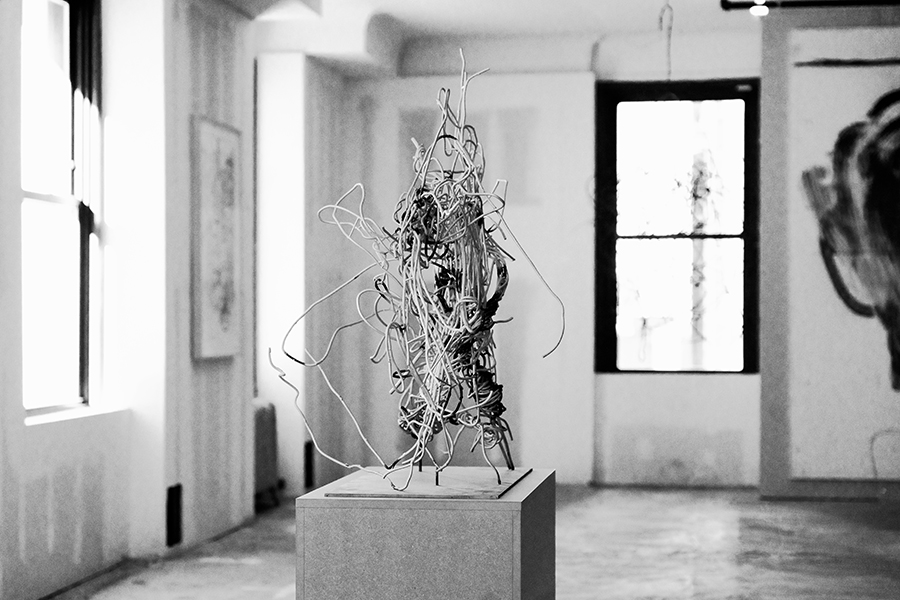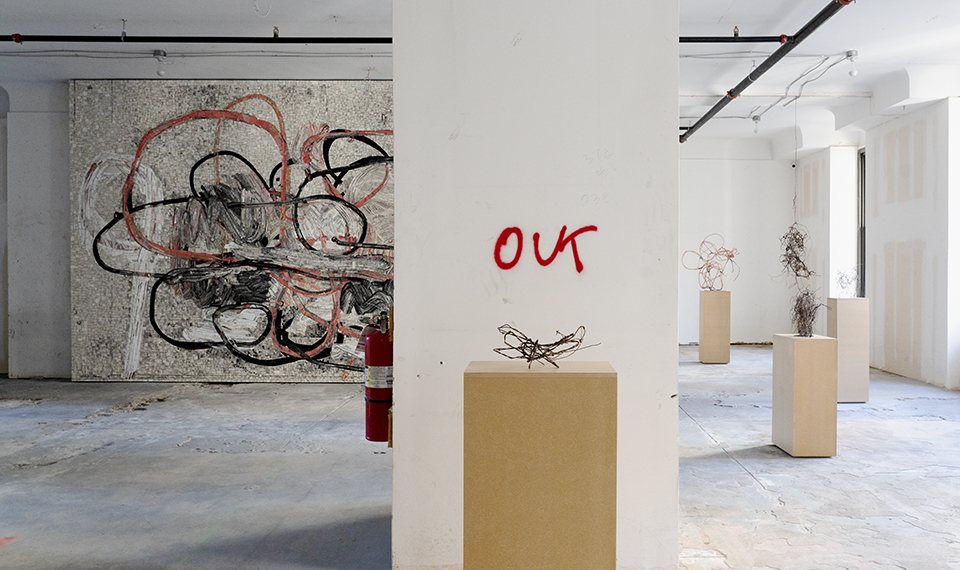Go and SEE STOP RUN
Richard Boch talks to the artist Christopher Wool about how he came to find the vacant and raw space in Lower Manhattan to showcase his latest works and what they were really looking to do.
You can walk or jump on the subway, but either way be sure to go and SEE STOP RUN.
There are no word paintings and no sign or mention of Apocalypse Now, Wool’s legendary 1988 word painting—a painting with its own Wikipedia page. There’s just ink and oil, paint and pencil and marker on whatever large or small surface works. There are photographs on the walls that offer a way to see what the artist sees—in addition to that are the books that present several series of photos along with a number of editioned large-format books. Taking it all in, we’re given the opportunity to explore a wide range of Wool’s work as well as a close look at the inspiration within the context and location of where the pieces were made. In many cases, the components—the intricate scrap and tangle of scrub and weed and wire found near his home in Marfa, Texas trade references with the darkness and light of gesture and mark-making that find their voice in the long ago nether regions of Lower Manhattan. They exist together and they stand alone but whichever way you look, it’s all about art. Making it, presenting it, and for us, appreciating it—or better yet, being moved by the process, the experience and the exhibition’s incredible setting.
I’m back for a second visit, standing in the middle of the vast and gutted 19th floor of 101 Greenwich Street, a century-old Downtown New York City office building—wires and pipes fully exposed, the sheetrock and floor well beyond needing just paint and repair. Pencil marks, spray-painted scribble and bits of not-quite-graffiti are here and there adding to what can only be described as an elegantly unhinged setting. Forty windows create a panorama featuring variations of sky and skyline and New York City light. Wandering and looking around, it all rings true, reminding me of the decades ago, once deserted beauty of what is now full-blown versions of SoHo, Tribeca and the Financial District. It’s past and present flashing in front of me and it all speaks with and to the work of artist Christopher Wool.
There’s a revelation in context—a rhythm and a history here—a graceful simplicity to what’s happening at SEE STOP RUN, Wool’s beautifully raw and broadly site-specific or rather site-sympatico survey of his recent and not-so-recent work. Like all great art, it’s taking us back and moving us forward at the same time.
I spoke with Wool about how he, his team and his long-time curator Anne Pontégnie came to find the nearly twenty-thousand square-foot space at 101 Greenwich Street, and what they were really looking to do. Hearing what he had to say set me thinking about my long-ago days living on Murray Street and working on White Street, when everyone I knew lived in a DIY world. It’s a then-and-now moment—beyond full circle—keeping me in the beautiful loop of what’s happening here on the 19th floor.

Untitled 2013 Wire 75 x 60 x 50 inches
Richard Boch: Hi Christopher. I’ll try to keep things linear and start at some version of the beginning. You grew up in Chicago, moved to New York sometime in the early 1970s, and you and I originally crossed paths at the Mudd Club during an era of rough-and-tumble downtown loft living. Many of us made those spaces our home and studio before we even had a shower, hot water or a refrigerator. Today, when you look at the hanging wires, the exposed layers of broken flooring and the gutted semi-wreckage of the 19th floor of 101 Greenwich Street, a building that’s well over one hundred years old, do you smile or laugh or think okay, this is the place for SEE STOP RUN?
Christopher Wool: Yes, it’s true. The loft building where I lived in Chinatown was actually in worse condition than 101 Greenwich Street. But I wasn’t thinking specifically of the ’70s when we went looking for a space for the show. When we found 101 Greenwich, we immediately saw the many possibilities this building had to offer despite or maybe because of the rawness. In Chinatown I had only two dank windows—here we have forty-seven. The light and views in this building are extraordinary. Most importantly, this space offered so much for the work to play off of. A completely different environment than the standard generic gallery or museum. I’ve found it exciting to see how context or environment can alter the meanings of the art itself.

Rear wall: Untitled 2023 Mosaic 11 x 16.5 feet; Foreground: Untitled 2019 Wire 6.5 x 15 x 6.5 inches
You’ve been showing at Luhring Augustine Gallery for decades, not to mention your 2013 Guggenheim retrospective. There have been a number of other museum shows and placements, as well as record auction prices—but let’s forget all that for a moment. Tell me what prompted or influenced you to step away and mount SEE STOP RUN independently. None of the work is for sale, it’s your first major show in a number of years and a lot of thought and effort went into putting it all together—so what’s it all about?
Anne Pontégnie curated a show of my work in 2001 where for the first time I exhibited photographs. Since that time, photography has become more and more integral to my practice and it seemed that an update to that 2001 show was in order. So this show was originally planned as an institutional show where, if necessary, we could borrow works, etc. As you point out, doing it this way made for a crazy amount of labor and effort on our part but we were able to keep our focus dedicated to what was most important to us. This show is much more like an institutional installation than a gallery show.
There’s that natural New York City light along with a view of buildings and sky and Trinity Church. The space, despite its raw nature, is comfortable in the sense that it’s easy to wander and look around. You can feel the vibe of both the setting and the work and how they speak to one another without really trying. I’ve heard you mention and seen the photo images of Marfa, Texas, where you spend a good deal of time, which is a very different setting than what’s happening here. How do these two locations connect?
I guess I’m the connection. New York and Marfa are so different in almost all ways, though I’m comfortable working in either place and have been able to make work about each place. I certainly don’t feel that work made in one place should necessarily be only shown in that place but maybe this show starts to ask those questions.

Left: Untitled 2020 Oil and Inkjet on Paper 22 x 17 inches; Right: Untitled 2021 Oil and Inkjet on Paper 31 x 22 inches
I like the idea of exploring those questions and how the show may begin to do that, but when I consider Downtown New York and Marfa, I can’t help but think of your work, not only in terms of location but in terms of influence and mood and vibe. The word paintings you’ve done in the past—what they say and what they don’t say, along with their points of reference—they seem different yet strangely and beautifully connected to the work in SEE STOP RUN. Am I overthinking?
Maybe. But as I said earlier, I have been able to make photographic works specific to both locations. And I suppose I have formed emotional bonds with both places. 101 Greenwich has reinvigorated my old love for New York City which had dimmed over the decades, and being able to flee to West Texas during the pandemic was a gift. For me, West Texas is all about the light but 101 Greenwich being at the tip of Manhattan offers its own beautiful coastal light as well. I’m not sure how I might connect much older work like the text paintings of 30 years ago but a central curatorial point for this choice of works is their interconnectedness.
Appreciating both the memories and the new reality of Lower Manhattan together with my limited awareness of that vast tumbled beauty of West Texas, are these places where you and your work feel most at home? Are there other settings you’d like to explore? Are the white wall and white-wine gallery days less important or less appealing to you at this point?
Having two places to feel at home is valuable in the same way that, for an artist, changing mediums keeps the work from going stale. Again, the show is somewhat about keeping things moving forward in any way possible. Change is a big part of that.
Christopher, thanks so much for taking the time to do this. Any last words or last thoughts?
Maybe I’ve said enough. I get tired of the sound of my own voice. Anyone interested should come down and see the show. As an artist, it’s not what I say that matters, it’s what is in the work that counts.

Untitled 2023 Silkscreen Ink on Linen 120 x 96 inches
SEE STOP RUN
Through July 31
Thursday – Sunday
12:00 – 6:00PM
101 Greenwich St.
(entrance on Rector St.)
New York, N.Y. 10006
19th Floor
Free and open to the public.
***
INTERVIEW Richard Boch
PHOTOGRAPHY Courtesy of the artist
Richard Boch writes GrandLife’s New York Stories column and is the author of The Mudd Club, a memoir recounting his time as doorman at the legendary New York nightspot, which doubled as a clubhouse for the likes of Jean-Michel Basquiat, Keith Haring, Debbie Harry and Talking Heads among others. To hear about Richard’s favorite New York spots for art, books, drinks, and more, read his Locals interview—here.